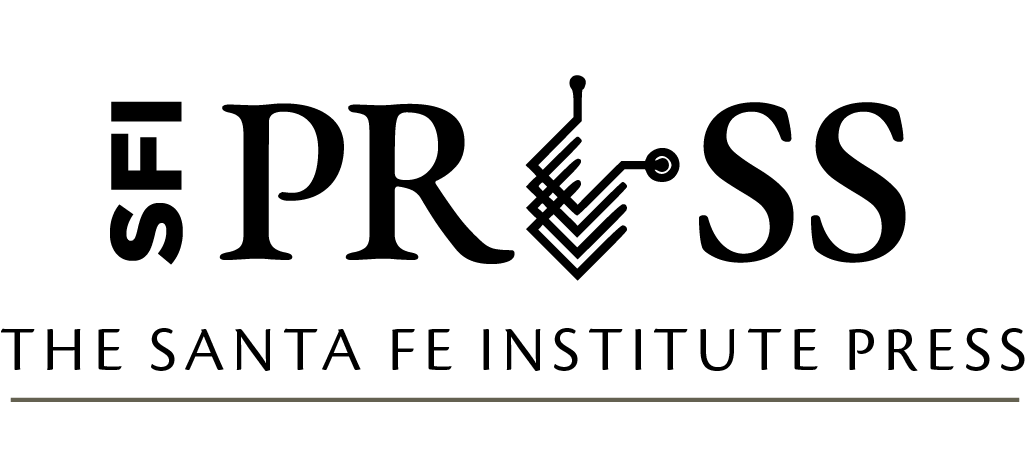Foundational Papers in Complexity Science pp. 2809–2833
DOI: 10.37911/9781947864559.88
Mesocosmos: In Search of Universal Laws of Living Material
Author: Christopher P. Kempes, Santa Fe Institute
Excerpt
Cells occupy an unusual position in the grand scale of things, not truly atomic, but not truly macroscopic either. For example, the smallest bacterial cells are composed of millions of atoms, yet certain macromolecules, such as the ribosome, exist in very small quantities (e.g., there are < 100 ribosomes for the smallest bacteria) (Kempes et al. 2017). This discreteness has downstream consequences, for example, as the intrinsic noise associated with randomly splitting a small pool of molecules into two daughter cells. In describing the physics of cells we are caught between the relatively easy physics of single atoms, where quantum mechanics dominates, and the classical physics of macroscopic systems such as hydraulics. This is exactly the point of Robert Laughlin, David Pines, Jörg Schmalian, Branko P. Stojković, and Peter Wolynes in “The Middle Way.” They aren’t just interested in cells but in all “mesoscopic” matter, with a particular interest in biological matter. The advances in condensed matter physics and material science associated with mesoscopic phenomena have been immense since the time that “The Middle Way” was published (e.g., Fish, Wagner, and Keten 2021), but here I want to focus on the biological aspects of this foundational paper, where the mesoscopic is relevant to everything from protein folding to the structure of tissues in multicellular organisms. Indeed, the mesoscopic is still at the heart of the ongoing revolution occurring in biological matter, both from the perspective of detailed dynamics and in terms of broad organizing principles and concepts.
Bibliography
Banks, D. S., and C. Fradin. 2005. “Anomalous Diffusion of Proteins Due to Molecular Crowding.” Biophysical Journal 89 (5): 2960–71. https://doi.org/10.1529/biophysj.104.051078.
England, J. L. 2013. “Statistical Physics of Self-Replication.” The Journal of Chemical Physics 139 (12). https://doi.org/10.1063/1.4818538.
Fish, J., G. J. Wagner, and S. Keten. 2021. “Mesoscopic and Multiscale Modelling in Materials.” Nature Materials 20:774–786. https://doi.org/10.1038/s41563-020-00913-0.
Hyman, A. A., C. A. Weber, and F. Jülicher. 2014. “Liquid-Liquid Phase Separation in Biology.” Annual Review of Cell and Developmental Biology 30:39–58. https://doi.org/10.1146/annurev-cellbio-100913-013325.
Kempes, C. P., S. Dutkiewicz, and M. J. Follows. 2011. “Growth, Metabolic Partitioning, and the Size of Microorganisms.” Proceedings of the National Academy of Sciences 109 (2): 495–500. https://doi.org/10.1073/pnas.1115585109.
Kempes, C. P., and D. C. Krakauer. 2021. “The Multiple Paths to Multiple Life.” Journal of Molecular Evolution 89:415–426. https://doi.org/10.1007/s00239-021-10016-2.
Kempes, C. P., D. H. Wolpert, Z. Cohen, and J. Pérez-Mercader. 2017. “The Thermodynamic Efficiency of Computations Made in Cells Across the Range of Life.” Philosophical Transactions of the Royal Society A: Mathematical, Physical and Engineering Sciences 375 (2109): 20160343. https://doi.org/10.1098/rsta.2016.0343.
Klosin, A., F. Oltsch, T. Harmon, A. Honigmann, F. Jülicher, A. A. Hyman, and C. Zechner. 2020. “Phase Separation Provides a Mechanism to Reduce Noise in Cells.” Science 367:464–8. https://doi.org/10.1126/science.aav6691.
Kolchinsky, A., and D. H. Wolpert. 2018. “Semantic Information, Autonomous Agency and Non-Equilibrium Statistical Physics.” Interface Focus 8 (6): 20180041. https://doi.org/10.1098/rsfs.2018.0041.
Laughlin, S. B., R. de Ruyter van Steveninck, and J. C. Anderson. 1998. “The Metabolic Cost of Neural Information.” Nature Neuroscience 1:36–41. https://doi.org/10.1038/236.
McSwiggen, D. T., M. Mir, X. Darzacq, and R. Tjian. 2019. “Evaluating Phase Separation in Live Cells: Diagnosis, Caveats, and Functional Consequences.” Genes & Development 33 (23-24): 1619–34. https://doi.org/10.1101/gad.331520.119.
Mehta, P., and D. J. Schwab. 2012. “Energetic Costs of Cellular Computation.” Proceedings of the National Academy of Sciences 109 (44): 17978–82. https://doi.org/10.1073/pnas.1207814109.
Minamino, T., and K. Namba. 2004. “Self-Assembly and Type III Protein Export of the Bacterial Flagellum.” Microbial Physiology 7 (1-2): 5–17. https://doi.org/10.1159/000077865.
Ouldridge, T. E., and Pieter Rein ten Wolde. 2017. “Fundamental Costs in the Production and Destruction of Persistent Polymer Copies.” Physical Review Letters 118 (15): 158103.
Pantaloni, D., C. L. Clainche, and M.-F. Carlier. 2001. “Mechanism of Actin-Based Motility.” Science 292 (5521): 1502–1506. https://doi.org/10.1126/science.1059975.
Qu, Z., D. Schildknecht, S. Shadkhoo, E. Amaya, J. Jiang, H. J. Lee, D. Larios, F. Yang, R. Phillips, and M. Thomson. 2021. “Persistent Fluid Flows Defined by Active Matter Boundaries.” Communications Physics 4 (198): 1–9.
Rao, R., and M. Esposito. 2016. “Nonequilibrium Thermodynamics of Chemical Reaction Networks: Wisdom from Stochastic Thermodynamics.” Physical Review X 6 (4): 041064. https://doi.org/10.1103/PhysRevX.6.041064.
Thompson, D. W. 1917. On Growth and Form. Cambridge, UK: Cambridge University Press.
West, G. 2017. Scale: The Universal Laws of Life, Growth, and Death in Organisms, Cities, and Companies. New York, NY: Penguin.
